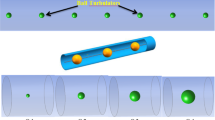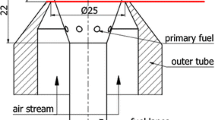Abstract
Rifled fillisters milled on cannular frustums were utilized to increase turbulence intensity (T.I.). Four configurations of unrifled, inner-rifled, outer-rifled, and two-faced rifled frustums were utilized to increase T.I. and mixing index (η). The mixing indices were calculated by measuring the concentrations of carbon dioxide (\( C_{{{\text{CO}}_{ 2} }} \)) and oxygen (\( C_{{{\text{O}}_{ 2} }} \)) behind the pure-jet nozzle and bluff-body frustums. The riled helical fillisters intensify the interaction and mixing between central flow and annular-air flow. Flow characteristics behind the pure-jet nozzles and bluff-body frustums were analyzed by smoke-wire flow visualization, vortex-shedding anemometry, and gas analyzer. The smoke-streak flow patterns behind the pure-jet nozzle were characterized by jet-flow and vortex-shedding patterns. Three flow patterns of jet-flow, recirculation-flow, and turbulent-flow were characterized behind the bluff-body frustums. The experimental results showed that Strouhal number (St) increases with T.I., and high central-jet Reynolds number (Re c) induces a low St. The \( \eta_{{{\text{CO}}_{ 2} }} \) increases with T.I. and the maximum \( \eta_{{{\text{CO}}_{ 2} }} \)of 64 % occurs behind the two-faced rifled frustum when T.I. = 4.5 %. The \( \eta_{{{\text{O}}_{ 2} }} \)increases with T.I., and \( \eta_{{{\text{O}}_{ 2} }} \) has maximum of 98 % occurring behind the two-faced rifled frustum when T.I. = 3.5 %.
Graphical Abstract

.












Similar content being viewed by others
Abbreviations
- A a :
-
Exit area of annular jet: π(D 2o –D 2)/4, 392.7 mm2
- A c :
-
Exit area of central jet: πd 2/4, 19.6 mm2
- C:
-
Concentration
- D:
-
Base diameter of frustum, 20 mm
- D i :
-
Top diameter of frustum, 15 mm
- D h :
-
Hydraulic diameter of annular jet at frustum exit: D o-D, 10 mm
- D a :
-
Annular jet at nozzle exit: D o–D i , 15 mm
- D o :
-
Outer diameter of annular jet at exit, 30 mm
- d:
-
Exit diameter of central jet, 5 mm
- f:
-
Vortex-shedding frequency (Hz)
- K.E.:
-
Kinetic energy (\( = \frac{{\overline{{u^{'2} }} + \overline{{v^{'2} }} }}{2} \))
- Q a :
-
Volumetric flow rate of annular jet
- Q c :
-
Volumetric flow rate of central jet
- Re c :
-
Central-jet Reynolds number: Re c = \( \frac{{u_{c} d\rho_{CO2} }}{{\mu_{CO2} }} \)
- r:
-
Radial coordinate, originated at center of bluff-body frustums
- S:
-
Velocity ratio (= u a/u c)
- St:
-
Strouhal number of vortex shedding: fD h /u turbulence intensity near the frustum exit at (x/D, r/D) = (0.2, 0)
- T.I.:
-
(=\( \frac{{\sqrt {(u^{\prime 2} + v^{\prime 2} )/2} }}{{\sqrt {u_{c}^{2} + u_{a}^{2} } }} \))
- u:
-
Axial velocity
- \( u_{a} \) :
-
Volumetric mean axial velocity of annular jet at exit: Q a /A a
- \( u_{c} \) :
-
Volumetric mean velocity of central jet at exit: Q c /A c
- v:
-
Radial velocity
- x:
-
Axial coordinate, originated at center of bluff-body frustums
- η:
-
Mixing index
References
Al-Abdeli YM, Masri AR (2003) Recirculation and flowfield regimes of unconfined non-reacting swirling flows. Exp Thermal Fluid 27(5):655–665
Carmody T (1964) Establishment of the wake behind a disk. J Basic Eng 86:869–882
Cheng RK (1995) Velocity and scalar characteristics of premixed turbulent flames stabilized by weak swirl. Combust Flame 101(1–2):1–14
Chigier NA, Beer JM (1964) Velocity and static pressure distributions in swirling air jets issuing from annular and divergent nozzles. ASME J Fluids Eng 86:788–798
Davies TW, Beer JM (1971) Flow in the wake of bluff-body flame stabilizers. In: Proceedings of the Thirteenth Symposium (Int.) on Combustion. The Combustion Institute, Pittsburgh, pp 631–638
Durao DFG, Whitelaw JH (1978) Velocity characteristics of the flow in the near wake of a disk. J Fluid Mech 86:369–385
Hartnett JP, Eckert ERG (1957) Experiment study of the velocity and temperature distribution in a high velocity vortex type flow. ASME J Fluid Eng 79:751–757
Huang RF, Tsai FC (2001) Observations of swirling flows behind circular discs. AIAA J 39(6):1106–1112
Huang RF, Yen SC (2003) Axisymmetric swirling vortical wakes modulated by a control disc. AIAA J 41(5):888–896
Hübner AW, Tummers MJ, Hanjalić K, van der Meer ThH (2003) Experiments on a rotating-pipe swirl burner. Exp Thermal Fluid Sci 27(4):481–489
Mueller TJ (2000) Flow visualization by direct injection. In: Goldstein RJ (ed) Fluid Mechanics Measurements, 2nd edn. Taylor & Francis, Washington DC, pp 367–450
Nathan GJ, Mi J, Alwahabi ZT, Newbold GJR, Nobes DS (2006) Impacts of a jet’s exit flow pattern on mixing and combustion performance. Prog Energy Combust Sci 32:496–538
Roquemore WM, Tankin RS, Chiu HH, Lottes SA (1986) A study of a bluff-body combustor using laser sheet lighting. Exp Fluids 4:205–213
Rose WG (1962) A swirling round turbulent jet 1-mean-flow measurements. J Appl Mech 29:615–625
San KC, Hsu HJ (2009) Characteristics of flow and flame behavior behind rifled/unrifled nozzles. ASME J Eng Gas Turbines Power 131:051501–051512
San KC, Lee YK (2011) Characteristics of cold-flow modes and gas-concentration distributions behind a novel unconfined nozzle. IMechE—Part C. J Mech Eng Sci 226:123–132
Schefer RW, Namazian M, Kelly J (1994) Velocity measurement in turbulent bluff-body stabilized flows. AIAA J 32:1844–1851
Wong CY, Nathan GJ, O’Doherty T (2004) The effect of initial conditions on the exit flow from a fluidic precessing jet nozzle. Exp Fluids 36:70–81
Acknowledgments
This research was supported by the National Science Council of the Republic of China, under Grant No. NSC 98-2221-E-019-040-MY3.
Author information
Authors and Affiliations
Corresponding author
Rights and permissions
About this article
Cite this article
San, K.C., Huang, Y.Z. & Yen, S.C. Cold-flow patterns and mixing index behind/near rifled bluff-body frustums. J Vis 16, 229–246 (2013). https://doi.org/10.1007/s12650-013-0168-z
Received:
Revised:
Accepted:
Published:
Issue Date:
DOI: https://doi.org/10.1007/s12650-013-0168-z




